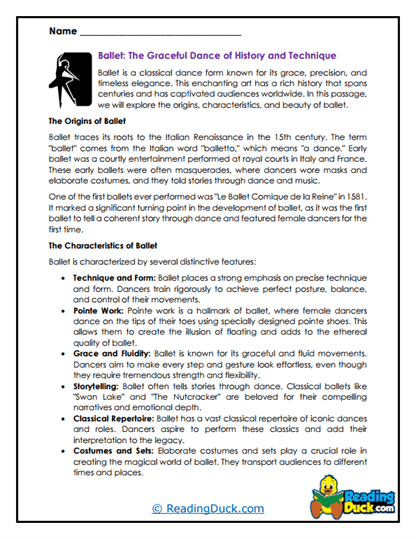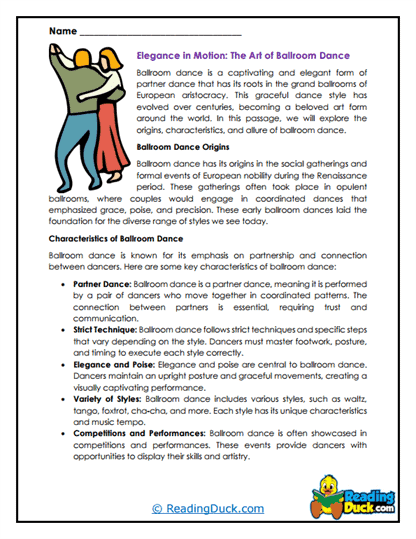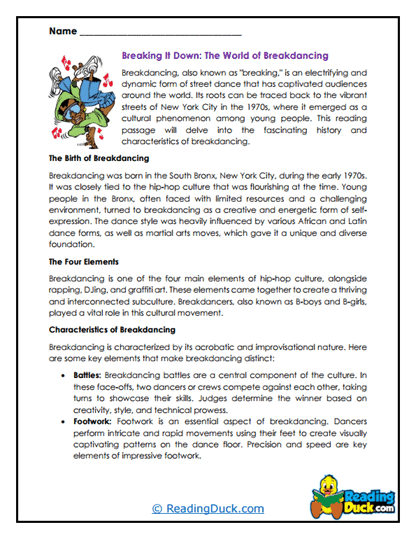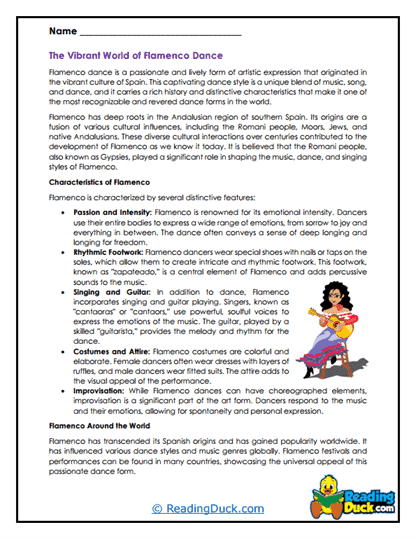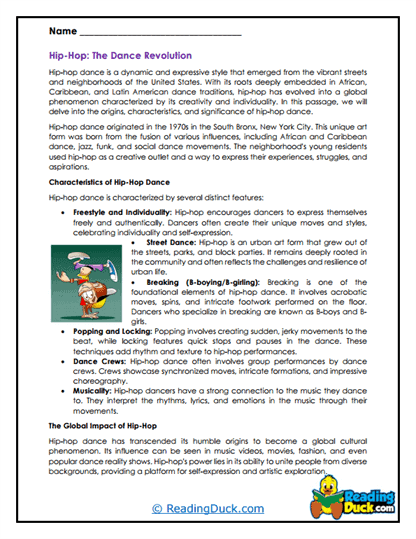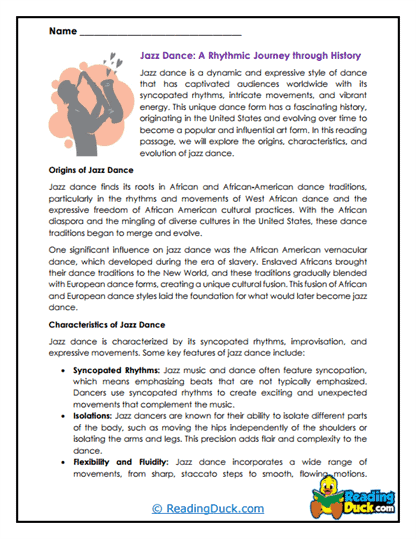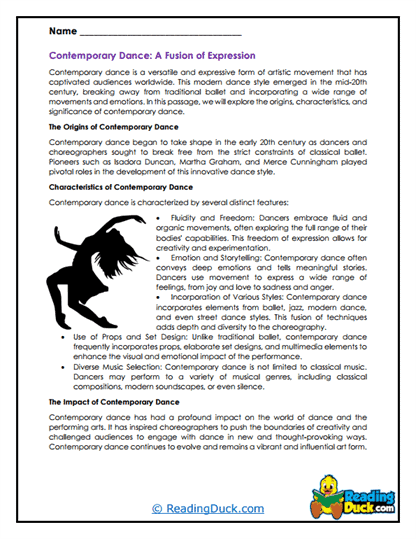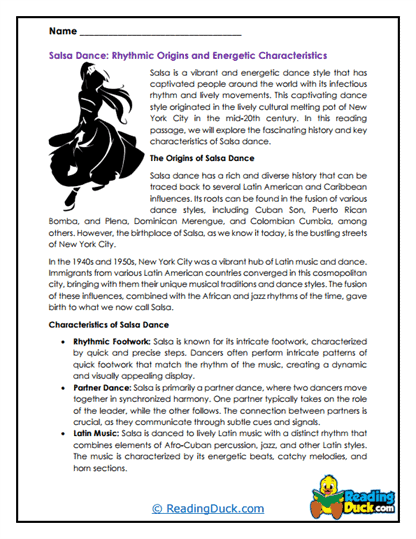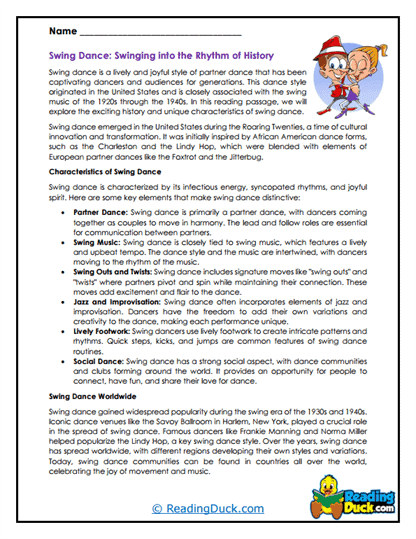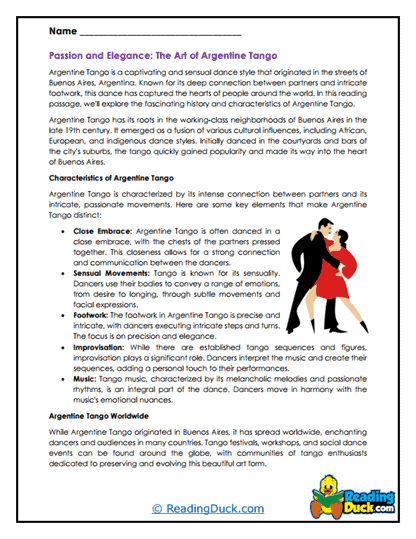Dance Styles Worksheets
About Our Dance Styles Worksheets
Our Dance Styles Worksheets offer students an engaging and thorough exploration of the vibrant world of dance. These worksheets delve into the history, development, and cultural significance of various dance styles. While this topic falls under the "Culture" category, it does not focus on comparing dance styles across cultures. Instead, the worksheets explore dance as a significant cultural expression, touching on its historical roots, notable dancers, and the art of choreography.
This topic contains several worksheet sets, each focusing on a specific aspect of dance styles. Each worksheet set includes:
- Multiple Choice Questions: These questions assess students' comprehension of the reading passages, focusing on key details about different dance styles, their origins, and their impact on culture.
- Short Answer Questions: Students are prompted to provide concise responses, summarizing important information, analyzing the evolution of dance styles, and reflecting on the significance of dance in various contexts.
- Open-Ended Questions: These questions encourage students to think critically and express their personal interpretations, opinions, and preferences related to the dance styles they have read about, deepening their connection to the material.
These worksheets help students demonstrate their understanding of dance as an art form and cultural expression while fostering meaningful engagement with the subject. An answer key is provided for each question sheet, making it easy for teachers and parents to evaluate student progress. All worksheets are available as PDF files, which can be easily viewed electronically, downloaded, and printed.
The Rhythm of Expression: Exploring Dance Styles
Dance is a universal language that transcends cultural boundaries and speaks directly to the human spirit. It is both an art form and a means of communication, allowing individuals to express emotions, tell stories, and connect with others through movement. Dance styles are as diverse as the cultures that created them, each with its own unique history, technique, and significance. By studying dance styles, students can gain a deeper appreciation for the role dance plays in shaping culture and identity, while also exploring the physical and artistic aspects of dance.
When studying dance styles, students encounter a variety of key concepts and areas of interest:
- Historical Development of Dance Styles: Dance has a rich history that dates back to ancient civilizations. Students learn about the origins of various dance styles, such as ballet, which emerged in the courts of Renaissance Italy and France; tap dance, which developed in the African American communities of the United States; and classical Indian dance forms like Bharatanatyam, which have been performed for thousands of years. By understanding the historical context of these dance styles, students can appreciate how they have evolved over time and how they continue to influence modern dance.
- Cultural Significance of Dance: Dance is deeply rooted in cultural traditions and often serves as a way to preserve and transmit cultural heritage. Students explore how different dance styles reflect the values, beliefs, and customs of the cultures from which they originated. For example, they might study the traditional folk dances of various regions, such as the Irish jig, the Spanish flamenco, or the Hawaiian hula, and learn how these dances are used in celebrations, rituals, and storytelling. By examining the cultural significance of dance, students gain insight into how dance connects people to their history and community.
- Techniques and Choreography: Each dance style is characterized by specific techniques and movements that define its unique aesthetic. Students delve into the technical aspects of various dance styles, learning about the precise footwork of ballet, the rhythmic patterns of hip-hop, and the fluid movements of contemporary dance. They also explore the art of choreography, understanding how dancers and choreographers create sequences of movements that convey a story, emotion, or theme. This exploration of techniques and choreography helps students appreciate the skill and creativity involved in dance.
- Influential Dancers and Choreographers: Dance has been shaped by the contributions of many talented dancers and choreographers who have pushed the boundaries of the art form. Students learn about influential figures in the world of dance, such as Martha Graham, who revolutionized modern dance; Michael Jackson, whose iconic moves defined an era; and Misty Copeland, who broke barriers in ballet. By studying the lives and works of these artists, students can see how individual creativity and innovation have shaped the evolution of dance.
- Contemporary Dance Styles: Dance continues to evolve, with new styles emerging in response to changing cultural and social landscapes. Students explore contemporary dance styles such as hip-hop, which originated in the streets of New York City; K-pop dance, which has gained global popularity; and fusion dance forms that blend elements of different styles. They also examine how technology and media have influenced the way dance is created, performed, and shared with audiences around the world. This exploration of contemporary dance styles encourages students to think about how dance reflects and responds to modern society.
Through these topics, students gain a well-rounded understanding of dance as both an art form and a cultural expression. They learn to appreciate the diversity of dance styles and the ways in which dance connects people across time and space.
Where To Use These Worksheets
Integrating dance styles worksheets into a curriculum can enhance students' learning experience across various subjects and grade levels. Here are some practical ideas on how and where these worksheets can be used:
- Physical Education and Dance Classes: Use these worksheets to introduce students to the history and techniques of various dance styles. Students can study the background of a dance style, learn basic steps, and then practice choreographing their own dance sequences. This approach combines physical activity with cultural education, helping students develop both their physical skills and their understanding of dance as an art form.
- History and Social Studies Classes: Incorporate the worksheets into lessons on world history and culture to help students explore the historical development of dance styles and their cultural significance. Students can analyze how dance reflects social changes, political movements, and cultural exchanges throughout history. For example, they might study how jazz dance emerged during the Harlem Renaissance or how traditional dances have been preserved and adapted in the face of globalization.
- Art and Music Classes: Include the worksheets in art and music classes to explore the connections between dance, visual arts, and music. Students can study how music and rhythm influence dance styles, analyze the costumes and stage designs associated with different dances, or create their own dance-inspired art projects. This interdisciplinary approach fosters creativity and helps students see the connections between different forms of artistic expression.
- Literature and Language Arts Classes: Use the worksheets to explore themes of movement, expression, and storytelling in literature and poetry. Students can analyze how authors use dance as a metaphor or symbol in their writing, or they might create their own stories or poems inspired by a specific dance style. This approach encourages students to think about how dance communicates ideas and emotions in ways that complement the written word.
- Career and Technical Education (CTE): Integrate the worksheets into CTE programs focused on performing arts, dance education, or event management. These materials can help students explore career paths in the dance industry, such as becoming a professional dancer, choreographer, dance therapist, or dance teacher. Students can also learn about the business side of dance, including how dance companies are managed and how performances are produced and marketed.
- Cultural Studies and Anthropology Classes: Include the worksheets in cultural studies or anthropology classes to explore the role of dance in different societies. Students can research traditional dance forms, analyze the cultural significance of dance rituals, or study the impact of colonization and cultural exchange on indigenous dance traditions. This approach helps students understand the broader cultural context of dance and its role in shaping identity and community.
- Extracurricular Activities: Use the worksheets in dance clubs, theater groups, or cultural organizations to deepen students' understanding of dance styles. Students can apply the knowledge they gain from the worksheets to their performances, choreography projects, or cultural presentations, enhancing both their practical skills and their appreciation for dance as a cultural expression.
Skill Development Through Dance Styles Worksheets
Studying dance styles through these worksheets can significantly enhance students' cultural awareness, creativity, and physical coordination. Dance requires not only physical skill but also an understanding of rhythm, timing, and expression. By exploring different dance styles, students develop a deeper appreciation for the diversity of cultural practices and artistic traditions around the world.
In addition to academic benefits, studying dance helps students build valuable life skills such as discipline, teamwork, and self-expression. Understanding the cultural significance of dance also fosters empathy and global awareness, encouraging students to appreciate the rich tapestry of human expression and the ways in which dance connects us across cultures and generations.
Overall, these dance styles worksheets provide a comprehensive and engaging way for students to explore the world of dance, gain a deeper understanding of its cultural significance, and develop skills that will serve them in their academic and personal lives.
